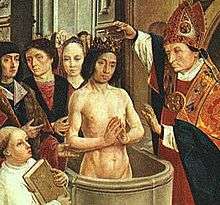Dutch people
Dutch people (Dutch: ![]()
Nederlanders | |
|---|---|
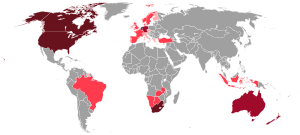 People of Dutch ancestry worldwide | |
| Total population | |
| c. 28–29 million[a] | |
| Regions with significant populations | |
(Citizens with both parents born in the Netherlands) | |
| 4,121,000[2] | |
| 3,000,000[3][4] | |
| 1,112,000[5] | |
| 336,000[6] | |
| 128,000[7] | |
| 121,000[8] | |
| 100,000[9] | |
| 60,000[10] | |
| 56,000[11] | |
| 30,000[12] | |
| 20,000[13] | |
| 15,000[12] | |
| 15,000[14] | |
| 13,000[15] | |
| 11,000[16] | |
| 10,000[12] | |
| 10,000[17] | |
| Languages | |
| Primarily Dutch and other regional languages: Dutch Low Saxon,[lower-alpha 1] Limburgish[lower-alpha 2][18] West Frisian (Friesland),[lower-alpha 3][19][20] English (BES Islands),[lower-alpha 4][21] Papiamento (Bonaire)[lower-alpha 5][21][22] | |
| Religion | |
| Historically or traditionally Christian (Protestant and Roman Catholic)[23] | |
| Related ethnic groups | |
| |
| |
The Dutch people are often seen as the pioneers of capitalism, and their emphasis on a modern economy, secularism, and a free market has been hugely influential worldwide.[33][34]
The traditional arts and culture of the Dutch encompasses various forms of traditional music, dances, architectural styles and clothing, some of which are globally recognizable. Internationally, Dutch painters such as Rembrandt, Vermeer and Van Gogh are held in high regard. The dominant religion of the Dutch was Christianity (both Catholic and Protestant), although in modern times the majority are no longer religious. Significant percentages of the Dutch are adherents of humanism, agnosticism, atheism or individual spirituality.[35][36]
History
.jpg)
Emergence
As with all ethnic groups, the ethnogenesis of the Dutch (and their predecessors) has been a lengthy and complex process. Though the majority of the defining characteristics (such as language, religion, architecture or cuisine) of the Dutch ethnic group have accumulated over the ages, it is difficult (if not impossible) to clearly pinpoint the exact emergence of the Dutch people; the interpretation of which is often highly personal. The text below hence focuses on the history of the Dutch ethnic group; for Dutch national history, please see the history-articles of the Netherlands. For Dutch colonial history, see the article on the Dutch Empire.
General
In the first centuries CE, the Germanic tribes formed tribal societies with no apparent form of autocracy (chiefs only being elected in times of war), beliefs based Germanic paganism and speaking a dialect still closely resembling Common Germanic. Following the end of the migration period in the West around 500, with large federations (such as the Franks, Vandals, Alamanni and Saxons) settling the decaying Roman Empire, a series of monumental changes took place within these Germanic societies. Among the most important of these are their conversion from Germanic paganism to Christianity, the emergence of a new political system, centered on kings, and a continuing process of emerging mutual unintelligibility of their various dialects.
Specific
The general situation described above is applicable to most if not all modern European ethnic groups with origins among the Germanic tribes, such as the Frisians, Germans, English and the North-Germanic (Scandinavian) peoples. In the Low Countries, this phase began when the Franks, themselves a union of multiple smaller tribes (many of them, such as the Batavi, Chauci, Chamavi and Chattuarii, were already living in the Low Countries prior to the forming of the Frankish confederation), began to incur the northwestern provinces of the Roman Empire. Eventually, in 358, the Salian Franks, one of the three main subdivisions among the Frankish alliance[38] settled the area's Southern lands as foederati; Roman allies in charge of border defense.[39]
Linguistically Old Frankish or Low Franconian gradually evolved into Old Dutch,[40][41] which was first attested in the 6th century,[42] whereas religiously the Franks (beginning with the upper class) converted to Christianity from around 500 to 700. On a political level, the Frankish warlords abandoned tribalism[43] and founded a number of kingdoms, eventually culminating in the Frankish Empire of Charlemagne.
However, the population make-up of the Frankish Empire, or even early Frankish kingdoms such as Neustria and Austrasia, was not dominated by Franks. Though the Frankish leaders controlled most of Western Europe, the Franks themselves were confined to the Northwestern part (i.e. the Rhineland, the Low Countries and Northern France) of the Empire.[44] Eventually, the Franks in Northern France were assimilated by the general Gallo-Roman population, and took over their dialects (which became French), whereas the Franks in the Low Countries retained their language, which would evolve into Dutch. The current Dutch-French language border has (with the exception of the Nord-Pas-de-Calais in France and Brussels and the surrounding municipalities in Belgium) remained virtually identical ever since, and could be seen as marking the furthest pale of gallicization among the Franks.[45]
Convergence
The medieval cities of the Low Countries, which experienced major growth during the 11th and 12th century, were instrumental in breaking down the already relatively loose local form of feudalism. As they became increasingly powerful, they used their economical strength to influence the politics of their nobility.[46][47][48] During the early 14th century, beginning in and inspired by the County of Flanders,[49] the cities in the Low Countries gained huge autonomy and generally dominated or greatly influenced the various political affairs of the fief, including marriage succession.
While the cities were of great political importance, they also formed catalysts for medieval Dutch culture. Trade flourished, population numbers increased dramatically, and (advanced) education was no longer limited to the clergy; Dutch epic literature such as Elegast (1150), the Roelantslied and Van den vos Reynaerde (1200) were widely enjoyed. The various city guilds as well as the necessity of water boards (in charge of dikes, canals, etc.) in the Dutch delta and coastal regions resulted in an exceptionally high degree of communal organization. It is also around this time, that ethnonyms such as Diets and Nederlands emerge.[50]
In the second half of the 14th century, the dukes of Burgundy gained a foothold in the Low Countries through the marriage in 1369 of Philip the Bold of Burgundy to the heiress of the Count of Flanders. This was followed by a series of marriages, wars, and inheritances among the other Dutch fiefs and around 1450 the most important fiefs were under Burgundian rule, while complete control was achieved after the end of the Guelders Wars in 1543, thereby unifying the fiefs of the Low Countries under one ruler. This process marked a new episode in the development of the Dutch ethnic group, as now political unity started to emerge, consolidating the strengthened cultural and linguistic unity.
Consolidation

Despite their linguistic and cultural unity, and (in the case of Flanders, Brabant and Holland) economic similarities, there was still little sense of political unity among the Dutch people.[51]
However, the centralist policies of Burgundy in the 14th and 15th centuries, at first violently opposed by the cities of the Low Countries, had a profound impact and changed this. During Charles the Bold's many wars, which were a major economic burden for the Burgundian Netherlands, tensions slowly increased. In 1477, the year of Charles' sudden death at Nancy, the Low Countries rebelled against their new liege, Mary of Burgundy, and presented her with a set of demands.
The subsequently issued Great Privilege met many of these demands, which included that Dutch, not French, should be the administrative language in the Dutch-speaking provinces and that the States-General had the right to hold meetings without the monarch's permission or presence. The overall tenure of the document (which was declared void by Mary's son and successor, Philip IV) aimed for more autonomy for the counties and duchies, but nevertheless all the fiefs presented their demands together, rather than separately. This is evidence that by this time a sense of common interest was emerging among the provinces of the Netherlands. The document itself clearly distinguishes between the Dutch speaking and French speaking parts of the Seventeen Provinces.
Following Mary's marriage to Maximilian I, Holy Roman Emperor, the Netherlands were now part of the Habsburg lands. Further centralized policies of the Habsburgs (like their Burgundian predecessors) again met with resistance, but, peaking with the formation of the collateral councils of 1531 and the Pragmatic Sanction of 1549, were still implemented. The rule of Philip II of Spain sought even further centralist reforms, which, accompanied by religious dictates and excessive taxation, resulted in the Dutch Revolt. The Dutch provinces, though fighting alone now, for the first time in their history found themselves fighting a common enemy. This, together with the growing number of Dutch intelligentsia and the Dutch Golden Age in which Dutch culture, as a whole, gained international prestige, consolidated the Dutch as an ethnic group.
National identity
By the middle of the 16th century an overarching, 'national' (rather than 'ethnic') identity seemed in development in the Habsburg Netherlands, when inhabitants began to refer to it as their 'fatherland' and were beginning to be seen as a collective entity abroad; however, the persistence of language barriers, traditional strife between towns, and provincial particularism continued to form an impediment to more thorough unification.[52] Following excessive taxation together with attempts at diminishing the traditional autonomy of the cities and estates in the Low Countries, followed by the religious oppression after being transferred to Habsburg Spain, the Dutch revolted, in what would become the Eighty Years' War. For the first time in their history, the Dutch established their independence from foreign rule.[53] However, during the war it became apparent that the goal of liberating all the provinces and cities that had signed the Union of Utrecht, which roughly corresponded to the Dutch-speaking part of the Spanish Netherlands, was unreachable. The Northern provinces were free, but during the 1580s the South was recaptured by Spain, and, despite various attempts, the armies of the Republic were unable to expel them. In 1648, the Peace of Münster, ending the Eighty Years' War, acknowledged the independence of the Dutch Republic, but maintained Spanish control of the Southern Netherlands. Apart from a brief reunification from 1815 until 1830, within the United Kingdom of the Netherlands (which included the Francophones/Walloons) the Dutch have been separated from the Flemings to this day.
Dutch Empire
The Dutch colonial empire (Dutch: Het Nederlandse Koloniale Rijk) comprised the overseas territories and trading posts controlled and administered by Dutch chartered companies (mainly the Dutch West India Company and the Dutch East India Company) and subsequently by the Dutch Republic (1581–1795), and by the modern Kingdom of the Netherlands after 1815. This and the innovations around it, has left behind a substantial legacy[54] despite the relatively small size of their country. The Dutch people have been pioneers of capitalism,[55][56] and their more recent emphasis on a modern economy, secularism, and a free market[34] ultimately had a huge influence on the great powers of the West, especially the British Empire, its Thirteen Colonies, and ultimately the United States.[57]
Ethnic identity
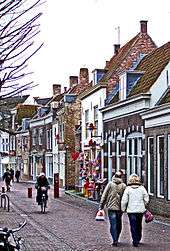
The ideologies associated with (Romantic) Nationalism of the 19th and 20th centuries never really caught on in the Netherlands, and this, together with being a relatively mono-ethnic society up until the late 1950s, has led to a relatively obscure use of the terms nation and ethnicity as both were largely overlapping in practice. Today, despite other ethnicities making up 19.6% of the Netherlands' population, this obscurity continues in colloquial use, in which Nederlander sometimes refers to the ethnic Dutch, sometimes to anyone possessing Dutch citizenship.[58] In addition to this, many Dutch people will object to being called Hollanders as a national denominator on much the same grounds as many Welsh or Scots would object to being called English instead of British.
The (re)definition of Dutch cultural identity has become a subject of public debate in recent years following the increasing influence of the European Union and the influx of non-Western immigrants in the post-World War II period. In this debate 'typically Dutch traditions' have been put to the foreground.[59]
In sociological studies and governmental reports, ethnicity is often referred to with the terms autochtoon and allochtoon.[60] These legal concepts refer to place of birth and citizenship rather than cultural background and do not coincide with the more fluid concepts of ethnicity used by cultural anthropologists.
Greater Netherlands
As did many European ethnicities during the 19th century,[61] the Dutch also saw the emerging of various Greater Netherlands- and pan-movements seeking to unite the Dutch-speaking peoples across the continent. During the first half of the 20th century, there was a prolific surge in writings concerning the subject. One of its most active proponents was the historian Pieter Geyl, who wrote De Geschiedenis van de Nederlandsche stam (Dutch: The History of the Dutch tribe/people) as well as numerous essays on the subject.
During World War II, when both Belgium and the Netherlands fell to German occupation, fascist elements (such as the NSB and Verdinaso) tried to convince the Nazis into combining the Netherlands and Flanders. The Germans however refused to do so, as this conflicted with their ultimate goal, the Neuordnung (New Order) of creating a single pan-German racial state.[62] During the entire Nazi occupation, the Germans denied any assistance to Greater Dutch ethnic nationalism, and, by decree of Hitler himself, actively opposed it.[63]
The 1970s marked the beginning of formal cultural and linguistic cooperation between Belgium (Flanders) and the Netherlands on an international scale.
Statistics
The total number of Dutch can be defined in roughly two ways. By taking the total of all people with full Dutch ancestry, according to the current CBS definition, resulting in an estimated 16,000,000 Dutch people,[note 1] or by the sum of all people with both full and partial Dutch ancestry, which would result in a number around 25,000,000.
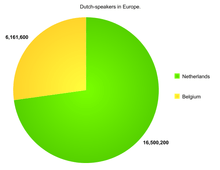 Dutch-speakers in Europe |
 People of Dutch ancestry outside the Netherlands |
Linguistics
Language

.png)
Dutch is the main language spoken by most Dutch people. It is a West Germanic language spoken by around 22 million people. Old Frankish, a precursor of the Dutch standard language, was first attested around 500,[64] in a Frankish legal text, the Lex Salica, and has a written record of more than 1500 years, although the material before around 1200 is fragmentary and discontinuous.
As a West Germanic language, Dutch is related to other languages in that group such as West Frisian, English and German. Many West Germanic dialects underwent a series of sound shifts. The Anglo-Frisian nasal spirant law and Anglo-Frisian brightening resulted in certain early Germanic languages evolving into what are now English and West Frisian, while the Second Germanic sound shift resulted in what would become (High) German. Dutch underwent none of these sound changes and thus occupies a central position in the West Germanic languages group.
Standard Dutch has a sound inventory of 13 vowels, 6 diphthongs and 23 consonants, of which the voiceless velar fricative (hard ch) is considered a well known sound, perceived as typical for the language. Other relatively well known features of the Dutch language and usage are the frequent use of digraphs like Oo, Ee, Uu and Aa, the ability to form long compounds and the use of slang, including profanity.
The Dutch language has many dialects. These dialects are usually grouped into six main categories; Hollandic, West-Flemish/Zeelandic, East Flemish, Brabantic, Limburgish and Dutch Saxon.[65] Of these dialects, Hollandic and Dutch Saxon are solely spoken by Northerners. Brabantic, East Flemish, West-Flemish/Zeelandic and Limburgish are cross border dialects in this respect. Lastly, the dialectal situation is characterised by the major distinction between 'Hard G' and 'Soft G' speaking areas (see also Dutch phonology). Some linguists subdivide these into approximately 28 distinct dialects.[66]
Dutch immigrants also exported the Dutch language. Dutch was spoken by some settlers in the United States as a native language from the arrival of the first permanent Dutch settlers in 1615, surviving in isolated ethnic pockets until about 1900, when it ceased to be spoken except by first generation Dutch immigrants. The Dutch language nevertheless had a significant impact on the region around New York. For example, the first language of American president Martin Van Buren was Dutch.[67][68] Most of the Dutch immigrants of the 20th century quickly began to speak the language of their new country. For example, of the inhabitants of New Zealand, 0.7% say their home language is Dutch,[69] despite the percentage of Dutch heritage being considerably higher.[70]
Dutch is currently an official language of the Netherlands, Belgium, Suriname, Aruba, Sint Maarten, Curaçao, the European Union and the Union of South American Nations (due to Suriname being a member). In South Africa, Afrikaans is spoken, a daughter language of Dutch, which itself was an official language of South Africa until 1983. The Dutch, Flemish and Surinamese governments coordinate their language activities in the Nederlandse Taalunie (Dutch Language Union), an institution also responsible for governing the Dutch Standard language, for example in matters of orthography.
Etymology of autonym and exonym
The origins of the word Dutch go back to Proto-Germanic, the ancestor of all Germanic languages, *theudo (meaning "national/popular"); akin to Old Dutch dietsc, Old High German diutsch, Old English þeodisc and Gothic þiuda all meaning "(of) the common (Germanic) people". As the tribes among the Germanic peoples began to differentiate its meaning began to change. The Anglo-Saxons of England for example gradually stopped referring to themselves as þeodisc and instead started to use Englisc, after their tribe. On the continent *theudo evolved into two meanings: Diets (meaning "Dutch (people)" (archaic)[71] and Deutsch (German, meaning "German (people)"). At first the English language used (the contemporary form of) Dutch to refer to any or all of the Germanic speakers on the European mainland (e.g. the Dutch, the Frisians and the Germans). Gradually its meaning shifted to the Germanic people they had most contact with, both because of their geographical proximity, but also because of the rivalry in trade and overseas territories: the people from the Republic of the Netherlands, the Dutch.
In the Dutch language, the Dutch refer to themselves as Nederlanders. Nederlanders derives from the Dutch word "Neder", a cognate of English "Nether" both meaning "low", and "near the sea" (same meaning in both English and Dutch), a reference to the geographical texture of the Dutch homeland; the western portion of the North European Plain.[72][73][74][75] Although not as old as Diets, the term Nederlands has been in continuous use since 1250.[50]
Names
Dutch surnames (and surnames of Dutch origin) are generally easily recognizable. There are several main types of surnames in Dutch:
- Patronymic surnames; the name is based on the personal name of the father of the bearer. Historically this has been by far the most dominant form. These type of names fluctuated in form as the surname was not constant. If a man called Willem Janssen (William, John's son) had a son named Jacob, he would be known as Jacob Willemsen (Jacob, Williams' son). Following civil registry, the form at time of registry became permanent. Hence today many Dutch people are named after ancestors living in the early 19th century when civil registry was introduced to the Low Countries. These names rarely feature tussenvoegsels.
- Toponymic surnames; the name is based on the location on which the bearer lives or lived. In Dutch this form of surname nearly always includes one or several tussenvoegsels, mainly van, van de and variants. Many emigrants removed the spacing, leading to derived names for well known people like Cornelius Vanderbilt.[76] While "van" denotes "of", Dutch surnames are sometimes associated with the upper class of society or aristocracy (cf. William of Orange). However, in Dutch van often reflects the original place of origin (Van Der Bilt – He who comes from De Bilt); rather than denote any aristocratic status.[77]
- Occupational surnames; the name is based on the occupation of the bearer. Well known examples include Molenaar, Visser and Smit. This practice is similar to English surnames (the example names translate perfectly to Miller, Fisher and Smith).[78]
- Cognominal surnames; based on nicknames relating to physical appearance/other features, on the appearance or character of the bearer (at least at the time of registration). For example "De Lange" (the tall one), "De Groot" (the big one), "De Dappere" (the brave one).
- Other surnames may relate to animals. For example; De Leeuw (The Lion), Vogels (Birds), Koekkoek (Cuckoo) and Devalck (The Falcon); to a desired social status; e.g., Prins (Prince), De Koninck/Koning (King), De Keyzer/keizer (Emperor); color; e.g. Rood (red) Blauw (blue) de Wit (the white). There is also a set of made up or descriptive names; e.g. Naaktgeboren (born naked).
Dutch names can differ greatly in spelling. The surname Baks, for example is also recorded as Backs, Bacxs, Bax, Bakx, Baxs, Bacx, Backx, Bakxs and Baxcs. Though written differently, pronunciation remains identical. Dialectal variety also commonly occurs, with De Smet and De Smit both meaning Smith for example. Surnames of Dutch migrants in foreign environments (mainly the English-speaking world and Francophonie) are often adapted, not only in pronunciation but also in spelling.
Culture

Religion
Prior to the arrival of Christianity, the ancestors of the Dutch adhered to a form of Germanic paganism augmented with various Celtic elements. At the start of the 6th century, the first (Hiberno-Scottish) missionaries arrived. They were later replaced by Anglo-Saxon missionaries, who eventually succeeded in converting most of the inhabitants by the 8th century.[79] Since then, Christianity has been the dominant religion in the region.
In the early 16th century, the Protestant Reformation began to form and soon spread in the Westhoek and the County of Flanders, where secret open-air sermons were held, called hagenpreken ("hedgerow orations") in Dutch. The ruler of the Dutch regions, Philip II of Spain, felt it was his duty to fight Protestantism and, after the wave of iconoclasm, sent troops to crush the rebellion and make the Low Countries a Catholic region once more.[80] The Protestants in the southern Low Countries fled North en masse.[80] Most of the Dutch Protestants were now concentrated in the free Dutch provinces north of the river Rhine, while the Catholic Dutch were situated in the Spanish-occupied or -dominated South. After the Peace of Westphalia in 1648, Protestantism did not spread South, resulting in a difference in religious situations that lasts to this day.
Contemporary Dutch are generally nominally Christians.[81] People of Dutch ancestry in the United States and South Africa are generally more religious than their European counterparts; for example, the numerous Dutch communities of western Michigan remain strongholds of the Reformed Church in America and the Christian Reformed Church, both descendants of the Dutch Reformed Church.
Cultural divergences
One cultural division within Dutch culture is that between the Protestant North and the Catholic South, which encompasses various cultural differences between the Northern Dutch on one side and the Southern Dutch on the other. This subject has historically received attention from historians, notably Pieter Geyl (1887–1966) and Carel Gerretson (1884–1958). The historical pluriformity of the Dutch cultural landscape has given rise to several theories aimed at both identifying and explaining cultural divergences between different regions. One theory, proposed by A.J. Wichers in 1965, sees differences in mentality between the southeastern, or 'higher', and northwestern, or 'lower' regions within the Netherlands, and seeks to explain these by referring to the different degrees to which these areas were feudalised during the Middle Ages.[82] Another, more recent cultural divide is that between the Randstad, the urban agglomeration in the West of the country, and the other provinces of the Netherlands.
In Dutch, the cultural division between North and South is also referred to by the colloquialism "below/above the great rivers" as the rivers Rhine and Meuse roughly form a natural boundary between the Northern Dutch (those Dutch living North of these rivers), and the Southern Dutch (those living South of them). The division is partially caused by (traditional) religious differences, with the North predominantly Protestant and the South having a majority of Catholics. Linguistic (dialectal) differences (positioned along the Rhine/Meuse rivers [sic].) and to a lesser extent, historical economic development of both regions are also important elements in any dissimilarity.
On a smaller scale cultural pluriformity can also be found; be it in local architecture or (perceived) character. This wide array of regional identities positioned within such a relatively small area, has often been attributed to the fact that many of the current Dutch provinces were de facto independent states for much of their history, as well as the importance of local Dutch dialects (which often largely correspond with the provinces themselves) to the people who speak them.[83]
Northern Dutch culture
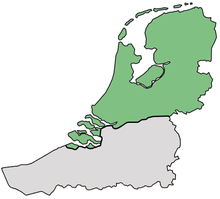
Northern Dutch culture is marked by Protestantism. Though today many do not adhere to Protestantism anymore, or are only nominally part of a congregation, Protestant-(influenced) values and custom are present. Generally, it can be said the Northern Dutch are more pragmatic, favor a direct approach, and display a less-exuberant lifestyle when compared to Southerners.[85] On a global scale, the Northern Dutch have formed the dominant vanguard of the Dutch language and culture since the fall of Antwerp, exemplified by the use of "Dutch" itself as the demonym for the country in which they form a majority; the Netherlands. Linguistically, Northerners speak any of the Hollandic, Zeelandic, and Dutch Low Saxon dialects natively, or are influenced by them when they speak the Standard form of Dutch. Economically and culturally, the traditional centre of the region have been the provinces of North and South Holland, or today; the Randstad, although for a brief period during the 13th or 14th century it lay more towards the east, when various eastern towns and cities aligned themselves with the emerging Hanseatic League. The entire Northern Dutch cultural area is located in the Netherlands, its ethnically Dutch population is estimated to be just under 10,000,000.[note 2] Northern Dutch culture has been less influenced by French influence than the Southern Dutch culture area.[86]
Frisians
Frisians, specifically West Frisians, are an ethnic group present in the north of the Netherlands, mainly concentrated in the province of Friesland. Culturally, modern Frisians and the (Northern) Dutch are rather similar; the main and generally most important difference being that Frisians speak West Frisian, one of the three sub-branches of the Frisian languages, alongside Dutch, and they find this to be a defining part of their identity as Frisians.[87]
West Frisians are a part of the Interfrisian Council, established in 1956, which works to promote and develop linguistic and cultural ties across the wider area of Frisia. The council also calls upon the German and Dutch governments to promote the language and culture in respective regions.[87]
According to a 1970 inquiry, West Frisians identified themselves more with the Dutch than with East Frisians or North Frisians.[88] A study in 1984 found that 39% of the inhabitants of Friesland considered themselves "primarily Frisian," although without precluding also being Dutch. A further 36 per cent claimed they were Dutch, but also Frisian, the remaining 25% saw themselves as only Dutch.[89] Nevertheless Frisians are not disambiguated from the Dutch people in Dutch official statistics.[90]
Many West Frisians maintain cultural ties with the other Frisian groups in nearby areas, and across national borders.[91]
Southern Dutch culture
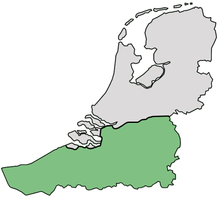
The Southern Dutch sphere generally consists of the areas in which the population was traditionally Catholic. During the early Middle Ages up until the Dutch Revolt, the Southern regions were more powerful, as well as more culturally and economically developed.[85] At the end of the Dutch Revolt, it became clear the Habsburgs were unable to reconquer the North, while the North's military was too weak to conquer the South, which, under the influence of the Counter-Reformation, had started to develop a political and cultural identity of its own.[92] The Southern Dutch, including Dutch Brabant and Limburg, remained Catholic or returned to Catholicism. The Dutch dialects spoken by this group are Brabantic, South Guelderish, Limburgish and East and West Flemish. In the Netherlands, an oft-used adage used for indicating this cultural boundary is the phrase boven/onder de rivieren (Dutch: above/below the rivers), in which 'the rivers' refer to the river Rhine and Meuse. Southern Dutch culture has been influenced more by French culture, opposed to the Northern Dutch culture area.[86]
Flemings
Within the field of ethnography, it is argued that the Dutch-speaking populations of the Netherlands and Belgium have a number of common characteristics, with a mostly shared language, some generally similar or identical customs, and with no clearly separate ancestral origin or origin myth.[93]
However, the popular perception of being a single group varies greatly, depending on subject matter, locality, and personal background. Generally, the Flemish will seldom identify themselves as being Dutch and vice versa, especially on a national level.[94] This is partly caused by the popular stereotypes in the Netherlands as well as Flanders, which are mostly based on the "cultural extremes" of both Northern and Southern culture, including in religious identity. Though these stereotypes tend to ignore the transitional area formed by the Southern provinces of the Netherlands and most Northern reaches of Belgium, resulting in overgeneralizations.[95] This self-perceived split between Flemings and Dutch, despite the common language, may be compared to how Austrians do not consider themselves to be Germans, despite the similarities they share with southern Germans such as Bavarians. In both cases, the Catholic Austrians and Flemish do not see themselves as sharing the fundamentally Protestant-based identities of their northern counterparts.
In the case of Belgium, there is the added influence of nationalism as the Dutch language and culture were oppressed by the francophone government. This was followed by a nationalist backlash during the late 19th and early 20th centuries that saw little help from the Dutch government (which for a long time following the Belgian Revolution had a reticent and contentious relationship with the newly formed Belgium and a largely indifferent attitude towards its Dutch-speaking inhabitants)[96] and, hence, focused on pitting "Flemish" culture against French culture, resulting in the forming of the Flemish nation within Belgium, a consciousness of which can be very marked among some Dutch-speaking Belgians.[97]
Genetics
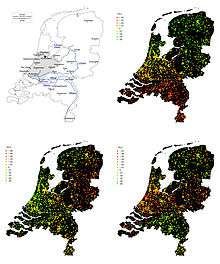
The largest patterns of human genetic variation within the Netherlands show strong correlations with geography and distinguish between: (1) North and South; (2) East and West; and (3) the middle-band and the rest of the country. The distribution of gene variants for eye colour, metabolism, brain processes, body height and immune system show differences between these regions that reflect evolutionary selection pressures.[98]
The largest genetic differences within the Netherlands are observed between the North and the South (with the three major rivers - Rijn, Waal, Maas - as a border), with the Randstad showing a mixture of these two ancestral backgrounds. The European North-South cline correlates highly with this Dutch North-South cline and shows several other similarities, such as a correlation with height (with the North being taller on average), blue/brown eye colour (with the North having more blue eyes), and genome-wide homozygosity (with the North having lower homozygosity levels). The correlation with genome-wide homozygosity likely reflects the serial founder effect that was initiated with the ancient successive out-of-Africa migrations. This does not necessarily mean that these events (north-ward migration and evolutionary selection pressures) took place within the borders of the Netherlands; it could also be that Southern Europeans have migrated more to the South of the Netherlands, and/or Northern Europeans more to the Northern parts.[98]
The North-South differences were likely maintained by the relatively strong segregation of the Catholic South and the Protestant North during the last centuries. During the last 50 years or so there was a large increase of non-religious individuals in the Netherlands. Their spouses are more likely to come from a different genetic background than those of religious individuals, causing non-religious individuals to show lower levels of genome-wide homozygosity than Catholics or Protestants.[99]
Dutch diaspora
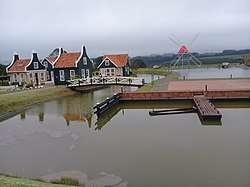
Since World War II, Dutch emigrants have mainly departed the Netherlands for Canada, the Federal Republic of Germany, the United States, Belgium, Australia, and South Africa, in that order. Today, large Dutch communities also exist in the United Kingdom, France, Spain, Turkey, and New Zealand.[28]
Central and Eastern Europe
During the German eastward expansion (mainly taking place between the 10th and 13th century),[100] a number of Dutchmen moved as well. They settled mainly east of the Elbe and Saale rivers, regions largely inhabited by Polabian Slavs[101] After the capture of territory along the Elbe and Havel Rivers in the 1160s, Dutch settlers from flooded regions in Holland used their expertise to build dikes in Brandenburg, but also settled in and around major German cities such as Bremen and Hamburg and German regions of Mecklenburg and Brandenburg.[102] From the 13th to the 15th centuries, Prussia invited several waves of Dutch and Frisians to settle throughout the country (mainly along the Baltic Sea coast)[103]
In the early-to-mid-16th century, Mennonites began to move from the Low Countries (especially Friesland and Flanders) to the Vistula delta region in Royal Prussia, seeking religious freedom and exemption from military service.[104] After the partition of Poland, the Prussian government took over and its government eliminated exemption from military service on religious grounds. The Mennonites emigrated to Russia. They were offered land along the Volga River. Some settlers left for Siberia in search for fertile land.[105] The Russian capital itself, Moscow, also had a number of Dutch immigrants, mostly working as craftsmen. Arguably the most famous of which was Anna Mons, the mistress of Peter the Great.
Historically Dutch also lived directly on the eastern side of the German border, most have since been assimilated (apart from ~40,000 recent border migrants), especially since the establishment of Germany itself in 1872. Cultural marks can still be found though. In some villages and towns a Dutch Reformed church is present, and a number of border districts (such as Cleves, Borken and Viersen) have towns and village with an etymologically Dutch origin. In the area around Cleves (Ger.Kleve, Du. Kleef) traditional dialect is Dutch, rather than surrounding (High/Low) German. More to the South, cities historically housing many Dutch traders have retained Dutch exonyms for example Aachen (Aken) and Cologne/Köln (Keulen) to this day.
Southern Africa
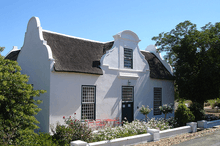
Although Portuguese explorers made contact with the Cape of Good Hope as early as 1488, much of present-day South Africa was ignored by Europeans until the Dutch East India Company established its first outpost at Cape Town, in 1652.[106][107] Dutch settlers began arriving shortly thereafter, making the Cape home to the oldest Western-based civilisation south of the Sahara.[108] Some of the earliest mulatto communities in the country were subsequently formed through unions between colonists, their slaves, and various Khoikhoi tribes.[109] This led to the development of a major South African ethnic group, Cape Coloureds, who adopted the Dutch language and culture.[107] As the number of Europeans—particularly women—in the Cape swelled, South African whites closed ranks as a community to protect their privileged status, eventually marginalising Coloureds as a separate and inferior racial group.[110]
Since Company employees proved inept farmers, tracts of land were granted to married Dutch citizens who undertook to spend at least twenty years in South Africa.[111] Upon the revocation of the Edict of Nantes in 1685, they were joined by French Huguenots fleeing religious persecution at home, who interspersed among the original freemen.[106] Between 1685 and 1707 the Company also extended free passage to any Dutch families wishing to resettle at the Cape.[112] At the beginning of the eighteenth century there were roughly 600 people of Dutch birth or descent residing in South Africa, and around the end of Dutch rule in 1806 the number had reached 13,360.[113]
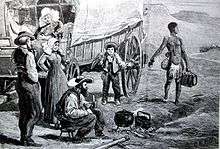
Some vrijburgers eventually turned to cattle ranching as trekboers, creating their own distinct sub-culture centered around a semi-nomadic lifestyle and isolated patriarchal communities.[108] By the eighteenth century there had emerged a new people in Africa who identified as "Afrikaners", rather than Dutchmen, after the land they had permanently adopted.[114]
Afrikaners are dominated by two main groups, the Cape Dutch and Boers, which are partly defined by different traditions of society, law, and historical economic bases.[108] Although their language (Afrikaans) and religion remain undeniably linked to that of the Netherlands,[115] Afrikaner culture has been strongly shaped by three centuries in South Africa.[114] Afrikaans, which developed from Middle Dutch, has been influenced by English, Malay-Portuguese creole, and various African tongues. Dutch was taught to South African students as late as 1914 and a few upper-class Afrikaners used it in polite society, but the first Afrikaans literature had already appeared in 1861.[108] The Union of South Africa granted Dutch official status upon its inception, but in 1925 Parliament openly recognised Afrikaans as a separate language.[108] It differs from Standard Dutch by several pronunciations borrowed from Malay, German, or English, the loss of case and gender distinctions, and in the extreme simplification of grammar.[116] The dialects are no longer considered quite mutually intelligible.[117]
During the 1950s, Dutch immigration to South Africa began to increase exponentially for the first time in over a hundred years. The country registered a net gain of around 45,000 Dutch immigrants between 1950 and 2001, making it the sixth most popular destination for citizens of the Netherlands living abroad.[28]
Southeast Asia
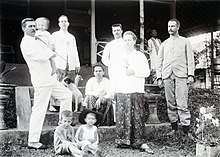
Since the 16th century, there has been a Dutch presence in South East Asia, Taiwan and Japan. In many cases the Dutch were the first Europeans the natives would encounter. Between 1602 and 1796, the VOC sent almost a million Europeans to work in the Asia.[118] The majority died of disease or made their way back to Europe, but some of them made the Indies their new home.[119] Interaction between the Dutch and native population mainly took place in Sri Lanka and the modern Indonesian Islands. Most of the time Dutch soldiers intermarried with local women and settled down in the colonies. Through the centuries there developed a relatively large Dutch-speaking population of mixed Dutch and Indonesian descent, known as Indos or Dutch-Indonesians. The expulsion of Dutchmen following the Indonesian Revolt, means that currently the majority of this group lives in the Netherlands. Statistics show that Indos are in fact the largest minority group in the Netherlands and number close to half a million (excluding the third generation).[120]
West Africa
Though many Ghanaians of European origin are mostly of British origin, there are a small number of Dutch people in Ghana. The forts in Ghana have a small number of a Dutch population. The most of the Dutch population is held in the place where the Netherlands has its embassy.
Australia and New Zealand
Though the Dutch were the first Europeans to visit Australia and New Zealand, colonization did not take place and it was only after World War II that a sharp increase in Dutch emigration to Australia occurred. Poor economic prospects for many Dutchmen as well as increasing demographic pressures, in the post-war Netherlands were a powerful incentive to emigrate. Due to Australia experiencing a shortage of agricultural and metal industry workers it, and to a lesser extent New Zealand, seemed an attractive possibility, with the Dutch government actively promoting emigration.[121]
The effects of Dutch migration to Australia can still be felt. There are many Dutch associations and a Dutch-language newspaper continues to be published. The Dutch have remained a tightly knit community, especially in the large cities. In total, about 310,000 people of Dutch ancestry live in Australia whereas New Zealand has some 100,000 Dutch descendants.[121]
North America

The Dutch had settled in America long before the establishment of the United States of America.[122] For a long time the Dutch lived in Dutch colonies, owned and regulated by the Dutch Republic, which later became part of the Thirteen Colonies.
Nevertheless, many Dutch communities remained virtually isolated towards the rest of America up until the American Civil War, in which the Dutch fought for the North and adopted many American ways.[123]
Most future waves of Dutch immigrants were quickly assimilated. There have been five American presidents of Dutch descent: Martin Van Buren (8th, first president who was not of British descent, first language was Dutch), Franklin D. Roosevelt (32nd, elected to four terms in office, he served from 1933 to 1945, the only U.S. president to have served more than two terms), Theodore Roosevelt (26th), as well as George H. W. Bush (41st) and George W. Bush (43rd), the latter two descendant from the Schuyler family.
The first Dutch people to come to Canada were Dutch Americans among the United Empire Loyalists. The largest wave was in the late 19th and early 20th centuries, when large numbers of Dutch helped settle the Canadian west. During this period significant numbers also settled in major cities like Toronto.
While interrupted by World War I, this migration returned in the 1920s, but again halted during the Great Depression and World War II. After the war a large number of Dutch immigrants moved to Canada, including a number of war brides of the Canadian soldiers who liberated the Low Countries.
See also
| Wikimedia Commons has media related to Notable Dutch people over the ages. |
| Wikiquote has quotations related to: Dutch proverbs |
- Afrikaner
- Dutch Brazil
- Dutch Chilean
- Dutch customs and etiquette
- Dutch Surinamese
- Flemish people
- List of Dutch people
- List of Germanic peoples
- Netherlands (terminology)
- Netherlands Antilles
- New Netherlands
Notes
- In the 1950s (the peak of traditional emigration) about 350,000 people left the Netherlands, mainly to Australia, New Zealand, Canada, the United States, Argentina and South Africa. About one-fifth returned. The maximum Dutch-born emigrant stock for the 1950s is about 300,000 (some have died since). The maximum emigrant stock (Dutch-born) for the period after 1960 is 1.6 million. Discounting pre-1950 emigrants (who would be about 85 or older), at most around 2 million people born in the Netherlands are now living outside the country. Combined with the 13.1 million ethnically Dutch inhabitants of the Netherlands, there are about 16 million people who are Dutch (of Dutch ancestry), in a minimally accepted sense. Autochtone population at 1 January 2006, Central Statistics Bureau, Integratiekaart 2006, (external link) (in Dutch)
- Estimate based on the population of the Netherlands, without the southern provinces and non-ethnic Dutch.
- Dutch Low Saxon, a variety of Low German spoken in northeastern Netherlands, is used by people who ethnically identify as "Dutch" despite perceived linguistic differences.
- Limburgish, a Low Franconian variety in close proximity to both Dutch and German, spoken in northeastern Netherlands is used by people who ethnically identify as Dutch or Flemings and regionally as "Limburgers" despite perceived linguistic differences.
- West Frisian is spoken by the ethnic Frisians, who may or may not also identify as "Dutch".
- The Caribbean Netherlands are treated as a municipality of the Netherlands and the inhabitants are considered in law and practice to be "Dutch", even if they might not identify as such personally.
- Papiamento, a Portuguese-based creole, is spoken by Arubans and Curaçaoans who may ethnically further also identify as "Dutch".
References
- Official CBS website containing all Dutch demographic statistics. Cbs.nl. Retrieved on 3 September 2016.
- Data Access and Dissemination Systems (DADS). "American FactFinder – Results". census.gov. Archived from the original on 14 February 2020. Retrieved 25 February 2020.
- "Afrikaners constitute nearly three million out of approximately 53 million inhabitants of the Republic of South Africa, plus as many as half a million in diaspora." Afrikaner – Unrepresented Nations and Peoples Organization. Retrieved 7 January 2020.
- Afrikaners make up approximately 5.2% of the total South African population based on the number of white South Africans who speak Afrikaans as a first language in the South African National Census of 2011.
- "Immigration and Ethnocultural Diversity Highlight Tables". statcan.gc.ca. 25 October 2017.
- "ABS Ancestry". 2012.
- Federal Statistics Office – Foreign population Archived 12 February 2012 at the Wayback Machine
- Number of people with the Dutch nationality in Belgium as reported by Statistic Netherlands Archived 6 July 2017 at the Wayback Machine (in Dutch)
- "New Zealand government website on Dutch-Australians". Teara.govt.nz. 4 March 2009. Retrieved 10 September 2012.
- res. "Présentation des Pays-Bas". France Diplomatie - Ministère de l'Europe et des Affaires étrangères (in French). Retrieved 19 June 2020.
- "Estimated overseas-born population resident in the United Kingdom by sex, by country of birth (Table 1.4)". Office for National Statistics. 28 August 2014. Retrieved 9 April 2015.
- Joshua Project. "Dutch Ethnic People in all Countries". Joshua Project. Retrieved 7 August 2012.
- "Archived copy" (PDF). Archived from the original (PDF) on 3 March 2016. Retrieved 18 March 2015.CS1 maint: archived copy as title (link)
- "CBS – One in eleven old age pensioners live abroad – Web magazine". Cbs.nl. 20 February 2007. Archived from the original on 5 February 2012. Retrieved 7 August 2012.
- "Table 5 Persons with immigrant background by immigration category, country background and sex. 1 January 2009". Ssb.no. 1 January 2009. Archived from the original on 15 November 2011. Retrieved 7 August 2012.
- "Dutch in Brazil". joshuaproject.com.
- https://www.migrationpolicy.org/programs/data-hub/charts/immigrant-and-emigrant-populations-country-origin-and-destination
- "Taal in Nederland .:. Nedersaksisch". taal.phileon.nl (in Dutch). Retrieved 3 January 2020.
- "Regeling - Instellingsbesluit Consultatief Orgaan Fries 2010 - BWBR0027230". wetten.overheid.nl (in Dutch). Retrieved 3 January 2020.
- "Taal in Nederland .:. Fries". taal.phileon.nl (in Dutch). Retrieved 3 January 2020.
- "wetten.nl - Regeling - Invoeringswet openbare lichamen Bonaire, Sint Eustatius en Saba - BWBR0028063". Wetten.overheid.nl (in Dutch). Retrieved 3 January 2020.
- "Regeling - Wet openbare lichamen Bonaire, Sint Eustatius en Saba - BWBR0028142". Wetten.overheid.nl (in Dutch). Retrieved 3 January 2020.
- Numbers, Ronald L. (2014). "Creationism in Europe". JHU Press. ISBN 9781421415628.
- Cole, Jeffrey E. (25 May 2011). Ethnic Groups of Europe: An Encyclopedia: An Encyclopedia. ABC-CLIO. p. 110. ISBN 978-1598843033. Retrieved 12 July 2015.
The Dutch (in Dutch: Nederlanders) are a Germanic people living in the Netherlands...
- Wicherkiewicz, Tomasz (2003). The Making of a Language. Walter de Gruyter. p. 449. ISBN 311017099X. Retrieved 26 March 2019.
The Germanic [peoples] still include: Englishmen, Dutchmen, Germans, Danes, Swedes, Saxons. Therefore, [in the same way] as Poles, Russians, Czechs, Serbs, Croats, Bulgarians belong to the Slavic [peoples]...
- Based on Statistics Canada, Canada 2001 Census.Link to Canadian statistics. Archived 25 February 2005 at the Wayback Machine
- "2001CPAncestryDetailed (Final)" (PDF). Retrieved 27 August 2010.
- Nicholaas, Han; Sprangers, Arno. "Dutch-born 2001, Figure 3 in DEMOS, 21, 4. Nederlanders over de grens". Nidi.knaw.nl. Archived from the original (PDF) on 11 June 2007.
- According to Factfinder.census.gov Archived 11 February 2020 at Archive.today
- Winkler Prins Geschiedenis der Nederlanden I (1977), p. 150; I.H. Gosses, Handboek tot de staatkundige geschiedenis der Nederlanden I (1974 [1959]), 84 ff.
- The actual independence was accepted by in the 1648 treaty of Munster, in practice the Dutch Republic had been independent since the last decade of the 16th century.
- D.J. Noordam, "Demografische ontwikkelingen in West-Europa van de vijftiende tot het einde van de achttiende eeuw", in H.A. Diederiks e.a., Van agrarische samenleving naar verzorgingsstaat (Leiden 1993), 35–64, esp. 40
- Lee, Richard E. (2012). The Longue Duree and World-Systems Analysis, p. 65
- Sobel, Andrew C. (2012). Birth of Hegemony: Crisis, Financial Revolution, and Emerging Global Networks, p. 54-88
- "CBS statline Church membership". Statline.cbs.nl. 15 December 2009. Retrieved 27 August 2010.
- Religion in the Netherlands. (in Dutch)
- 'Clovis' conversion to Christianity, regardless of his motives, is a turning point in Dutch history as the elite now changed their beliefs. Their choice would way down its way on the common folk, of whom many (especially in the Frankish heartland of Brabant and Flanders) were less enthusiastic than the ruling class. Taken from Geschiedenis van de Nederlandse stam, part I: till 1648. Page 203, 'A new religion', by Pieter Geyl. Wereldbibliotheek Amsterdam/Antwerp 1959.
- Britannica: "They were divided into three groups: the Salians, the Ripuarians, and the Chatti, or Hessians."(Link)
- Encyclopædia Britannica Online; entry 'History of the Low Countries'. 10 May. 2009;The Franks, who had settled in Toxandria, in Brabant, were given the job of defending the border areas, which they did until the mid-5th century
- Encyclopædia Britannica Online; entry 'Dutch language' 10 May. 2009; "It derives from Low Franconian, the speech of the Western Franks, which was restructured through contact with speakers of North Sea Germanic along the coast."
- Encyclopædia Britannica Online; entry 'West Germanic languages'. 10 May. 2009;restructured Frankish—i.e., Dutch;
- W. Pijnenburg, A. Quak, T. Schoonheim & D. Wortel, Oudnederlands Woordenboek. Archived 19 January 2016 at the Wayback Machine
- Encyclopædia Britannica Online; entry 'History of the Low Countries'. 10 May. 2009; The administrative organization of the Low Countries (...) was basically the same as that of the rest of the Frankish empire.
- Encyclopædia Britannica Online; entry 'History of the Low Countries'. 10 May. 2009;During the 6th century, Salian Franks had settled in the region between the Loire River in present-day France and the Coal Forest in the south of present-day Belgium. From the late 6th century, Ripuarian Franks pushed from the Rhineland westward to the Schelde. Their immigration strengthened the Germanic faction in that region, which had been almost completely evacuated by the Gallo-Romans.
- Encyclopædia Britannica Online; entry 'Fleming and Walloon'. 12 May. 2009;The northern Franks retained their Germanic language (which became modern Dutch), whereas the Franks moving south rapidly adopted the language of the culturally dominant Romanized Gauls, the language that would become French. The language frontier between northern Flemings and southern Walloons has remained virtually unchanged ever since.
- Encyclopædia Britannica Online (use fee site); entry 'History of the Low Countries'. 10 May. 2009;Thus, the town in the Low Countries became a communitas (sometimes called corporatio or universitas)—a community that was legally a corporate body, could enter into alliances and ratify them with its own seal, could sometimes even make commercial or military contracts with other towns, and could negotiate directly with the prince.
- Encyclopædia Britannica Online; entry 'History of the Low Countries'. 10 May. 2009;The development of a town's autonomy sometimes advanced somewhat spasmodically because of violent conflicts with the prince. The citizens then united, forming conjurationes (sometimes called communes)—fighting groups bound together by an oath—as happened during a Flemish crisis in 1127–28 in Ghent and Brugge and in Utrecht in 1159.
- Encyclopædia Britannica Online; entry 'History of the Low Countries'. 10 May. 2009;All the towns formed a new, non-feudal element in the existing social structure, and from the beginning merchants played an important role. The merchants often formed guilds, organizations that grew out of merchant groups and banded together for mutual protection while traveling during this violent period, when attacks on merchant caravans were common.
- Encyclopædia Britannica Online; entry 'History of the Low Countries'. 10 May. 2009;The achievements of the Flemish partisans inspired their colleagues in Brabant and Liège to revolt and raise similar demands; Flemish military incursions provoked the same reaction in Dordrecht and Utrecht
- Etymologisch Woordenboek van het Nederlands entry "Diets". (in Dutch)
- Becker, Uwe (2006). J. Huizinga (1960: 62). ISBN 9789055892754. Retrieved 27 August 2010.
- Cf. G. Parker, The Dutch Revolt (1985), 33–36, and Knippenberg & De Pater, De eenwording van Nederland (1988), 17 ff.
- Source, the aforementioned 3rd chapter (p3), together with the initial paragraphs of chapter 4, on the establishment of the Dutch Republic.
- Taylor, Peter J. (2002). Dutch Hegemony and Contemporary Globalization (Paper prepared for Political Economy of World-Systems Conference, Riverside, California). As Peter J. Taylor notes, "the Dutch developed a social formula, which we have come to call modern capitalism, that proved to be transferable and ultimately deadly to all other social formulations."
- Bornschier, Volker; Lengyel, Peter (1992). Waves, Formations and Values in the World System, p. 69. “The rise of capitalist national states (as opposed to city-states) was a European innovation, and the first of these was the Dutch Republic of the seventeenth century."
- Lachmann, Richard (2000). Capitalists in Spite of Themselves: Elite Conflict and European Transitions in Early Modern Europe, p. 158
- Wallerstein, Immanuel: The Modern World-System II: Mercantilism and the Consolidation of the European World-Economy, 1600–1750. (Academic Press, 1980)
- Figures based on a publication by the Netherlands National Institute for Public Health and the Environment (link).
- Shetter (2002), 201
- J. Knipscheer and R. Kleber, Psychologie en de multiculturele samenleving (Amsterdam 2005), 76 ff.
- cf. Pan-Germanism, Pan-Slavism and many other Greater state movements of the day.
- Het nationaal-socialistische beeld van de geschiedenis der Nederlanden by I. Schöffer. Amsterdam University Press. 2006. Page 92.
- For example he gave explicit orders not to create a voluntary Greater Dutch Waffen SS division composed of soldiers from the Netherlands and Flanders. (Link to documents)
- "Maltho thi afrio lito" is the oldest attested (Old) Dutch sentence, found in the Salic Law, a legal text written around 500. (Source; the Old Dutch dictionary) (in Dutch)
- Taaluniversum website on the Dutch dialects and main groupings. (in Dutch)
- Hüning, Matthias. "Kaart van de Nederlandse dialecten". University if Vienna. Archived from the original on 10 December 2006.
- Nicoline Sijs van der (2009). Cookies, Coleslaw, and Stoops: The Influence of Dutch on the North American Languages. Amsterdam University Press. p. 50.
Martin van Buren's mother tongue was Dutch
- Edward L. Widmer (2005). Martin Van Buren. The American Presidents Series. Times Books. pp. 6–7.
Van Buren grew up speaking Dutch, a relic of the time before the Revolution when the inland waterways of North America were a polyglot blend of non-Anglophone communities. His family has resisted intermarriage with Yankees for five generations, and Van Buren trumpeted the fact proudly in his autobiography
- 2006 New Zealand Census.
- As many as 100,000 New Zealanders are estimated to have Dutch blood in their veins (some 2% of the current population of New Zealand).
- Until World War II, Nederlander was used synonym with Diets. However the similarity to Deutsch resulted in its disuse when the German occupiers and Dutch fascists extensively used that name to stress the Dutch as an ancient Germanic people. (Source; Etymologisch Woordenboek) (in Dutch)
- See J. Verdam, Middelnederlandsch handwoordenboek (The Hague 1932 (reprinted 1994)): "Nederlant, znw. o. I) Laag of aan zee gelegen land. 2) het land aan den Nederrijn; Nedersaksen, -duitschland." (in Dutch)
- "Hermes in uitbreiding". Users.pandora.be. Retrieved 7 October 2017.
- neder- corresponds with the English nether-, which means "low" or "down".
- "Archived copy". Archived from the original on 6 December 2008. Retrieved 6 November 2008.CS1 maint: archived copy as title (link)
- See the history section of the Vanderbilt family article, or visit this link. Archived 20 May 2006 at the Wayback Machine
- "It is a common mistake of Americans, or anglophones in general, to think that the 'van' in front of a Dutch name signifies nobility." (Source. Archived 11 June 2007 at the Wayback Machine); "Von may be observed in German names denoting nobility while the van, van der, van de and van den (whether written separately or joined, capitalized or not) stamp the bearer as Dutch and merely mean 'at', 'at the', 'of', 'from' and 'from the' (Source: Genealogy.com), (Institute for Dutch surnames, in Dutch)
- Most common names of occupational origin. Source 1947 Dutch census. (in Dutch)
- The Anglo-Saxon Church – Catholic Encyclopedia article
- The Dutch Republic Its Rise, Greatness, and Fall 1477–1806, ISBN 0-19-820734-4
- A 2004 study conducted by Statistics Netherlands shows that 50% of the population claim to belong to a Christian denomination, 9% to other denominations and 42% to none. In the same study, 19% of the people claim go to church at least once a month, another 9% less than once a month, and 72% hardly ever or never. Statistical Yearbook of the Netherlands 2006, page 43 Archived 6 July 2017 at the Wayback Machine
- A.M. van der Woude, Nederland over de schouder gekeken (Utrecht 1986), 11–12. (in Dutch)
- Dutch Culture in a European Perspective; by D. Fokkema, 2004, Assen.
- This image is based on the rough definition given by in the 2005 " number 3" edition of the magazine "Neerlandia" by the ANV; it states the dividing line between both areas lies where "the great rivers divide the Brabantic from the Hollandic dialects and where Protestantism traditionally begins".
- Voor wie Nederland en Vlaanderen wil leren kennen. By J. Wilmots
- Fred M. Shelley, Nation Shapes: The Story Behind the World's Borders, 2013, page 97
- "Ynterfryske ferklearring (Inter-Frisian Declaration)". De Fryske Rie (The Frisian Council) (in Western Frisian). Retrieved 5 January 2020.
Wy wolle ús taal, dy't foar ús identiteit beskiedend is, befoarderje en útbouwe. (We want to promote and develop our language, which is defining for our identity)
- Frisia. 'Facts and fiction' (1970), by D. Tamminga. (in Dutch)
- Mahmood, Cynthia; Armstrong, Sharon L K (January 1992). "Do Ethnic Groups Exist?: A Cognitive Perspective on the Concept of Cultures". Ethnology. 31 (1): 1–14. doi:10.2307/3773438. JSTOR 3773438.
- "Bevolking (Population)". CBS Statline. cbs.nl. Retrieved 2 January 2020.
- "Ynterfryske ferklearring (Inter-Frisian Declaration)". De Fryske Rie (The Frisian Council) (in Western Frisian). Retrieved 5 January 2020.
Wy hearre ta mear as ien steat, mar fiele ús dochs, nettsjinsteande alles wat ús skiedt, as hearrend ta ien folk, dat neffens wenst en wollen de eigen taal ûnderhâlde en útbouwe wol. (We belong to more than one state, but still feel, notwithstanding everything that separates us, as though belonging to one people, who, according to our wishes and will, want to maintain and develop our own language.)
- Cf. Geoffrey Parker, The Dutch Revolt: "Gradually a consistent attitude emerged, a sort of 'collective identity' which was distinct and able to resist the inroads, intellectual as well as military, of both the Northern Dutch (especially during the crisis of 1632) and the French. This embryonic 'national identity' was an impressive monument to the government of the archdukes, and it survived almost forty years of grueling warfare (1621–59) and the invasions of Louis XIV until, in 1700, the Spanish Habsburgs died out." (Penguin edition 1985, p. 260). See also J. Israel, The Dutch Republic, 1477–1806, 461–463 (Dutch language version).
- National minorities in Europe, W. Braumüller, 2003, page 20.
- Nederlandse en Vlaamse identiteit, Civis Mundi 2006 by S.W Couwenberg. ISBN 90-5573-688-0. Page 62. Quote: "Er valt heel wat te lachen om de wederwaardigheden van Vlamingen in Nederland en Nederlanders in Vlaanderen. Ze relativeren de verschillen en beklemtonen ze tegelijkertijd. Die verschillen zijn er onmiskenbaar: in taal, klank, kleur, stijl, gedrag, in politiek, maatschappelijke organisatie, maar het zijn stuk voor stuk varianten binnen één taal-en cultuurgemeenschap." The opposite opinion is stated by L. Beheydt (2002): "Al bij al lijkt een grondiger analyse van de taalsituatie en de taalattitude in Nederland en Vlaanderen weinig aanwijzingen te bieden voor een gezamenlijke culturele identiteit. Dat er ook op andere gebieden weinig aanleiding is voor een gezamenlijke culturele identiteit is al door Geert Hofstede geconstateerd in zijn vermaarde boek Allemaal andersdenkenden (1991)." L. Beheydt, "Delen Vlaanderen en Nederland een culturele identiteit?", in P. Gillaerts, H. van Belle, L. Ravier (eds.), Vlaamse identiteit: mythe én werkelijkheid (Leuven 2002), 22–40, esp. 38. (in Dutch)
- Dutch Culture in a European Perspective: Accounting for the past, 1650–2000; by D. Fokkema, 2004, Assen.
- Geschiedenis van de Nederlanden, by J.C.H Blom and E. Lamberts, ISBN 978-90-5574-475-6; page 383. (in Dutch)
- Wright, Sue; Kelly-Holmes, Helen (1 January 1995). Languages in contact and conflict ... – Google Books. ISBN 9781853592782. Retrieved 27 August 2010.
- Abdellaoui, Abdel; Hottenga, Jouke-Jan; de Knijff, Peter; Nivard, Michel; Xiangjun, Xiao; Scheet, Paul; Brooks, Andrew; Ehli, Erik; Hu, Yueshan; Davies, Gareth; Hudziak, James; Sullivan, Patrick; van Beijsterveldt, Toos; Willemsen, Gonneke; de Geus, Eco; Penninx, Brenda; Boomsma, Dorret (27 March 2013). "Population structure, migration, and diversifying selection in the Netherlands". European Journal of Human Genetics. 21 (11): 1277–1285. doi:10.1038/ejhg.2013.48. PMC 3798851. PMID 23531865.
- Abdellaoui, Abdel; Hottenga, Jouke-Jan; Xiangjun, Xiao; Scheet, Paul; Ehli, Erik; Davies, Gareth; Hudziak, James; Smit, Dirk; Bartels, Meike; Willemsen, Gonneke; Brooks, Andrew; Sullivan, Patrick; Smit, Johannes; de Geus, Eco; Penninx, Brenda; Boomsma, Dorret (25 August 2013). "Association Between Autozygosity and Major Depression: Stratification Due to Religious Assortment". Behavior Genetics. 43 (6): 455–467. doi:10.1007/s10519-013-9610-1. PMC 3827717. PMID 23978897.
- Taschenatlas Weltgeschichte, part 1, by H. Kinder and W. Hilgemann. ISBN 978-90-5574-565-4, page 171. (German)
- "Boise State University thesis by E.L. Knox on the German Eastward Expansion ('Ostsiedlung')". Oit.boisestate.edu. Archived from the original on 27 December 2008. Retrieved 27 August 2010.
- Voortrekkers van Oud-Nederland; from Nederlands Geschiedenis buiten de grenzen" by J. Dekker (in Dutch)
- Thompson, James Westfall (7 October 2017). "Dutch and Flemish Colonization in Mediaeval Germany". American Journal of Sociology. 24 (2): 159–186. doi:10.1086/212889. JSTOR 2763957.
- "Article on Dutch settlers in Poland published by the Polish Genealogical Society of America and written by Z. Pentek". Pgsa.org. Archived from the original on 18 November 2010. Retrieved 27 August 2010.
- Article published by the Mercator Research center on Dutch settlers in Siberia Archived 2 January 2014 at the Wayback Machine
- Thomas McGhee, Charles C.; N/A, N/A, eds. (1989). The plot against South Africa (2nd ed.). Pretoria: Varama Publishers. ISBN 0-620-14537-4.
- Fryxell, Cole. To Be Born a Nation. pp. 9–327.
- Kaplan, Irving. Area Handbook for the Republic of South Africa. pp. 42–591.
- Nelson, Harold. Zimbabwe: A Country Study. pp. 237–317.
- Roskin, Roskin. Countries and concepts: an introduction to comparative politics. pp. 343–373.
- Hunt, John (2005). Campbell, Heather-Ann (ed.). Dutch South Africa: Early Settlers at the Cape, 1652–1708. Philadelphia: University of Pennsylvania Press. pp. 13–35. ISBN 978-1904744955.
- Keegan, Timothy. Colonial South Africa and the Origins of the Racial Order (1996 ed.). David Philip Publishers (Pty) Ltd. pp. 15–37. ISBN 978-0813917351.
- Entry: Cape Colony. Encyclopedia Britannica Volume 4 Part 2: Brain to Casting. Encyclopædia Britannica, Inc. 1933. James Louis Garvin, editor.
- Dowden, Richard (2010). Africa: Altered States, Ordinary Miracles. Portobello Books. pp. 380–415. ISBN 978-1-58648-753-9.
- "Is Afrikaans Dutch?". DutchToday.com. Archived from the original on 24 June 2012. Retrieved 10 September 2012.
- "Afrikaans language – Britannica Online Encyclopedia". Britannica.com. Retrieved 10 September 2012.
- "The Afrikaans Language | about | language". Kwintessential.co.uk. Archived from the original on 7 September 2012. Retrieved 10 September 2012.
- "Data". portal.unesco.org. Archived from the original on 17 December 2008.CS1 maint: BOT: original-url status unknown (link)
- "Easternization of the West: Children of the VOC". Dutchmalaysia.net. Archived from the original on 14 August 2009. Retrieved 27 August 2010.
- (in Dutch) Willems, Wim, 'De uittocht uit Indie 1945–1995' (Uitgeverij Bert Bakker, Amsterdam, 2001) ISBN 90-351-2361-1
- Nederland-Australie 1606–2006 on Dutch emigration. Archived 28 June 2010 at the Wayback Machine
- The U.S. declared its independence in 1776; the first Dutch settlement was built in 1614: Fort Nassau, where presently Albany, New York is positioned.
- "How the Dutch became Americans, American Civil War. (includes reference on fighting for the North)". Library.thinkquest.org. Archived from the original on 16 May 2012. Retrieved 27 August 2010.
Further reading
- Blom, J. C. H. and E. Lamberts, eds. History of the Low Countries (2006) 504pp excerpt and text search; also complete edition online
- Bolt, Rodney.The Xenophobe's Guide to the Dutch. Oval Projects Ltd 1999, ISBN 1-902825-25-X
- Boxer. Charles R. The Dutch in Brazil, 1624–1654. By The Clarendon Press, Oxford, 1957, ISBN 0-208-01338-5
- Burke, Gerald L. The making of Dutch towns: A study in urban development from the 10th–17th centuries (1960)
- De Jong, Gerald Francis. The Dutch in America, 1609–1974.Twayne Publishers 1975, ISBN 0-8057-3214-4
- Hunt, John. Dutch South Africa: early settlers at the Cape, 1652–1708. By John Hunt, Heather-Ann Campbell. Troubador Publishing Ltd 2005, ISBN 1-904744-95-8.
- Koopmans, Joop W., and Arend H. Huussen, Jr. Historical Dictionary of the Netherlands (2nd ed. 2007)excerpt and text search
- Kossmann-Putto, J. A. and E. H. Kossmann. The Low Countries: History of the Northern and Southern Netherlands (1987)
- Kroes, Rob. The Persistence of Ethnicity: Dutch Calvinist pioneers. By University of Illinois Press 1992, ISBN 0-252-01931-8
- Stallaerts, Robert. The A to Z of Belgium (2010), a historical encyclopedia
- White & Boucke. The UnDutchables. ISBN 978-1-888580-44-0.
External links

